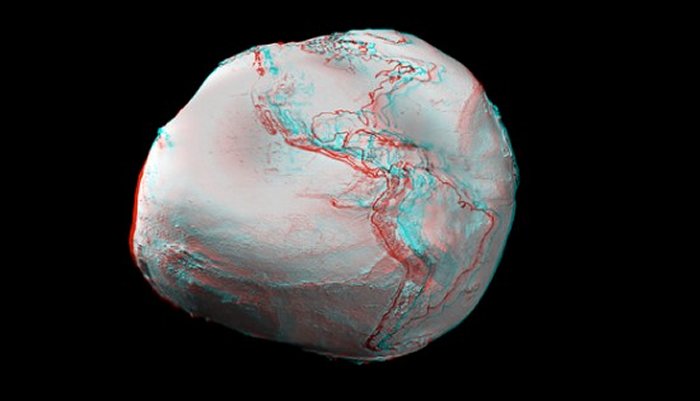Large Parts Of Canada Are Missing Gravity
MessageToEagle.com – Scientists have tried to solve the mystery of why large parts of Canada are missing gravity.
In the in the 1960s when the Earth’s global gravity fields were being mapped and registered, experts noticed a gravity anomaly in the Hudson Bay region and surrounding areas.
Compared to other parts of the world, gravity was much lower in these parts of Canada. How is it possible and what is behind this scientific enigma?
It is by no means uncommon that gravity varies on different parts of the Earth. Studies show that the Earth’s mass is not spread out proportionally and it can shift position over time.
Scientists are able to map Earth’s gravity field from space and to look for small changes from one year to another.
Some years ago, scientists at the Harvard-Smithsonian Center for Astrophysics and the University of Toronto, measure our planet’s gravity with help of a sensitive pair of NASA satellites named GRACE. The results of their study confirmed the current theory that that 20,000 years ago, Ice Age glaciers pressed down on the area’s crust like a person sitting on an extremely viscous waterbed.
The GRACE data allowed scientists to create topographical maps approximating what Hudson Bay looked like during the last ice age, when it was covered by the Laurentide Ice Sheet, which covered much of present-day Canada and the northern United States.
See also:
Door To Hell In Turkmenistan: Giant Darvaza Crater Has Been On Fire For Years
Earth’s Core Is As Hot As The Surface Of The Sun
This ice sheet was almost 2 miles (3.2 km) thick in most sections, and in two areas of Hudson Bay, it was 2.3 miles (3.7 km) thick. It was also very heavy and weighed down the Earth. Over a period of 10,000 years, the Laurentide Ice Sheet melted, finally disappearing 10,000 years ago. It left a deep indentation in the Earth.
Scientists discovered that the weight of all of that ice forced the mantle rocks to ooze slowly sideways. The ice melted rapidly enough the crust hasn’t yet fully bounced back. According to experts, the rebound accounts for about half of the gravity loss.
If a downwelling mantle plume was the culprit, then there wouldn’t be any detectable changes, because mantle convection occurs on fairly long time scales,” Mark Tamisiea, a geophysicist at the Proudman Oceanographic Laboratory in Liverpool, England said
There was a signal, however—the area’s gravity is increasing at a rate comparable to that which would occur if you poured two inches (five centimeters) of water across the region each year.
“It’s a fairly large signal,” Tamisiea said.

It probably means that the region is rebounding around half an inch (about a centimeter) per year.
It should be added that the ice sheet theory only accounts for 25 percent to 45 percent of the gravitational variation around Hudson Bay and the surrounding area. Subtracting the “rebound effect” from the area’s gravitational signal, scientists have determined that the remaining 55 percent to 75 percent of gravitational variation is likely due to convection.
Canada’s Hudson Bay area will experience less gravity for a long time. Scientists estimate that the Earth has to rebound more than 650 feet to get back to its original position, which should take about 5,000 years, but the rebound effect is still visible.
Although sea levels are rising around the world, the sea level along Hudson Bay’s coast is dropping as the land continues to recover from the weight of the Laurentide Ice Sheet.
MessageToEagle.com
Related Posts
-
 Supay: God Of Death And Underworld And Ruler Over Race Of Demons According to Inca Mythology
No Comments | Jun 1, 2016
Supay: God Of Death And Underworld And Ruler Over Race Of Demons According to Inca Mythology
No Comments | Jun 1, 2016 -
 How Dangerous Are The Biggest Solar Flares?
No Comments | May 5, 2016
How Dangerous Are The Biggest Solar Flares?
No Comments | May 5, 2016 -
 Humans Evolved Somewhere Else In The Galaxy – We Are Aliens On Our Own Planet – Scientist Says
No Comments | Jun 12, 2014
Humans Evolved Somewhere Else In The Galaxy – We Are Aliens On Our Own Planet – Scientist Says
No Comments | Jun 12, 2014 -
 Legend Of Brigadoon: Mythical Village Where Time Stands Still
No Comments | Nov 2, 2016
Legend Of Brigadoon: Mythical Village Where Time Stands Still
No Comments | Nov 2, 2016 -
 Incredible Padmanabhaswamy Temple And Its Ancient Treasures Hidden In Vaults Guarded By Serpents
No Comments | Jun 29, 2015
Incredible Padmanabhaswamy Temple And Its Ancient Treasures Hidden In Vaults Guarded By Serpents
No Comments | Jun 29, 2015 -
 Moths Are Masters Of Disguise
No Comments | May 4, 2016
Moths Are Masters Of Disguise
No Comments | May 4, 2016 -
 Boss Great Wall: Gigantic Wall Of Galaxies Located In Deep Space
No Comments | Sep 21, 2016
Boss Great Wall: Gigantic Wall Of Galaxies Located In Deep Space
No Comments | Sep 21, 2016 -
 Kudurru Of Melishihu – Stone Records From The Kassite Dynasty In Babylonia
No Comments | Jan 17, 2016
Kudurru Of Melishihu – Stone Records From The Kassite Dynasty In Babylonia
No Comments | Jan 17, 2016 -
 The Enigma Of The ‘Ancient Ones’, The Anasazi Cliff-Dwellers Of The Southwestern United States
No Comments | Apr 9, 2017
The Enigma Of The ‘Ancient Ones’, The Anasazi Cliff-Dwellers Of The Southwestern United States
No Comments | Apr 9, 2017 -
 Bad And Good Karma Depends On Us – We Are Architects Of Our Own Fate
No Comments | Aug 14, 2018
Bad And Good Karma Depends On Us – We Are Architects Of Our Own Fate
No Comments | Aug 14, 2018


